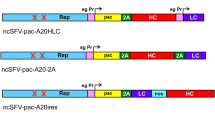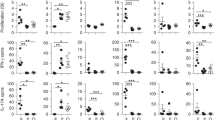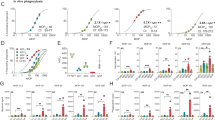Abstract
We have cloned immunoglobulin (Ig) genes from an Epstein-Barr (EB) virus-transformed human B cell line, FK-001, which produced a monoclonal human IgM that specifically binds Pseudomonas aeruginosa exotoxin A (Ex-A). Cloned Ig genomic DNA was introduced into Ig non-producing mouse myeloma cells, P3-X63-Ag-8-6.5.3. (653) and Sp2/0-Ag14 (Sp2/0), by protoplast fusion or electroporation using a series of pSV2 vectors. Transfectant-derived recombinant antibodies (r-Abs) and antibodies produced by the original cell FK-001 did not differ in binding specificity or affinity to Ex-A. Recombinant antibodies and those of FK-001 were pentameric although joining (J) genes of human origin were not introduced into the mouse myeloma cells. Heterogeneity in the molecular weights of r-Abs expressed in different mouse myeloma cells was observed, and shown to be due to differential N-glycosylation of the μ-chain polypeptides. Thus, human Ig μ and κ genomic DNA with its own promoters and enhancers can function efficiently in mouse myeloma cells in vivo resulting in transfectants that synthesize active human IgM.
This is a preview of subscription content, access via your institution
Access options
Subscribe to this journal
Receive 12 print issues and online access
$209.00 per year
only $17.42 per issue
Buy this article
- Purchase on Springer Link
- Instant access to full article PDF
Prices may be subject to local taxes which are calculated during checkout
Similar content being viewed by others
References
James, H. and Bell, G.T. 1987. Human monoclonal antibody production. Current status and future prospects. J. Immunol. Methods 100:5–40.
Stemitz, M., Klein, G., Koskimies, S. and Makel, O. 1977. EB virus-induced B lymphocyte cell lines producing specific antibody. Nature 269:420–422.
Schlom, J., Wunderlich, D. and Teramoto, Y.A. 1980. Generation of human monoclonal antibodies reactive with human mammary carcinoma cells. Proc. Natl. Acad. Sci. USA 77:6841–6845.
Olsson, L. and Kaplan, H.S. 1980. Human-human hybridomas producing monoclonal antibodies of predefined antigenic specificity. Proc. Natl. Acad. Sci USA 77:5429–5431.
Teng, N.N.H., Lam, K.S., Riera, F.C. and Kaplan, H.S. 1983. Contruction and testing of mouse-human heteromyelomas for human monoclonal antibody production. Proc. Natl. Acad. Sci. USA 80:7308–7312.
Vasil, M.L., Rabat, D. and Iglewski, B.H. 1977. Structure-activity relationship of an exotoxin of Pseudomonas aeruginosa. Infect. Immun. 16:353–361.
Gray, G.L., Smith, D.H., Baldridge, L.S., Harkins, R.H., Vasil, M.L., Chen, E.Y. and Heyneker, H.L. 1984. Cloning, nucleotide sequence, and expression in Escherichia coli of the exotoxin A structural gene of Pseudomonas aeruginosa. Proc. Natl. Acad. Sci. USA 81:2645–2649.
Southern, E.M. 1975. Detection of specific sequences among DNA fragments separated by gel electrophoresis. J. Mol. Biol. 98:503–517.
Parslow, T.G., Blair, D.L., Murphy, W.L. and Grannier, D.K. 1984. Structure of the 5′ ends of immunoglobulin genes: A novel conserved sequence. Proc. Natl. Acad. Sci. USA 81:2650–2654.
Falkner, F.G. and Zachau, H.G. 1984. Correct transcription of an immunoglobulin κ gene requires an upstream fragment containing conserved sequence elements. Nature 310:71–74.
Kabat, E.A., Wu, T.T., Bilofsky, H., Reind-Miller, M. and Perry, H. 1987. Sequences of Proteins of Immunological Interest. U. S. Department of Health and Human Services, N. I. H., Bethesda.
Klobeck, H.G., Bornkamm, G.W., Combriato, G., Mocikat, R., Pohlenz, H.D. and Zachau, H.G. 1985. Subgroup IV of human immunoglobulin K light chains is encoded by a single germline gene. Nucl. Acids Res. 13:6515–6529.
Hieter, P.A., Maizel, J.V. and Leder, P. 1982. Evolution of human immunoglobulin κJ region genes. J. Biol. Chem. 257:1516–1522.
Potter, H., Weir, L. and Leder, P. 1984. Enhancer-dependent expression of human κ immunoglobulin genes introduced into mouse pre-B lymphocytes by electroporation. Proc. Natl. Acad. Sci. USA 81:7161–7165.
Perucho, M., Hanahan, D. and Wigler, M. 1980. Genetic and physical linkage of exogeneous sequences in transformed cells. Cell 22:309–317.
Pellicer, A., Wigler, M., Axel, R. and Silverstein, S. 1978. The transfer and stable integration of the HSV thymidine kinase gene into mouse cells. Cell 14:133–141.
Sandri-Goldin, R.M., Goldin, A.L., Levine, M. and Glorioso, J.C. 1981. High frequency transfer of cloned herpes simplex virus type I sequences to mammalian cells by protoplast fusion. Mol. Cell. Biol. 1:743–752.
Morrison, S.L., Johnson, M.J., Herzenberg, L.A. and Oi, V.T. 1984. Chimeric human antibody molecules: Mouse antigen-binding domains with human constant region domains. Proc. Natl. Acad. Sci. USA 81:6851–6855.
Boulianne, S.H., Hozumi, N. and Shulman, M.J. 1984. Production of a functional chimaeric mouse/human antibody. Nature 312:643–646.
Sun, L.K., Curtis, P., Rakowicz-Szulczynska, E., Ghrayeb, J., Chang, N., Morrison, S. and Koprowski, H. 1987. Chimeric antibody with human constant regions and mouse variable regions directed against carcinoma-associated antigen 17-1 A. Proc. Natl. Acad. Sci. USA 84:214–218.
Kudo, A., Ishihara, T., Nishimura, Y. and Watanabe, T. 1985. A cloned human immunoglobulin heavy chain gene with a novel direct-repeat sequence in the 5′ flanking region. Gene 33:181–189.
Nishimura, Y., Yokoyama, M., Araki, K., Ueda, R. and Watanabe, T. 1987. Recombinant human-mouse chimeric monoclonal antibody specific for common acute lymphocytic leukemia antigen. Cancer Res 47:999–1005.
Koshland, M.E. 1983. The coming of age of the immunoglobulin J chain. Ann. Rev. Immunol. 3:425–453.
Takatsuki, A., Kohno, K. and Tamura, G. 1975. Inhibition of biosynthesis of polyisoprenol sugars in chick embryo microsomes by tunicamycin. Agr. Biol. Chem. 39:2089–2091.
Frischauf, A., Lehrach, H., Poustka, A. and Murray, N. 1983. Lambda replacement vectors carrying polylinkers sequences. J. Mol. Biol. 170:827–842.
Ravetch, J.F., Siebenlist, U., Korsmeyer, S., Waldmann, T. and Leder, P. 1981. Structure of human immunoglobulin μ locus: Characterization of embryonic and rearranged J and D genes. Cell 27:583–591.
Takahashi, T., Nakai, S. and Honjo, T. 1980. Cloning of human immunoglobulin gene and comparison with mouse μ gene. Nucl. Acids Res. 8:5983–5991.
Hanahan, D. 1983. Studies on transformation of Escherichia coli with plasmids. J. Mol. Biol. 166:557–580.
Yanisch-Perron, C., Vieira, J. and Messing, J. 1985. Improved M13 phage cloning vectors and host strains: Nucleotide sequences of the M13mpl8 and pUC19 vectors. Gene 33:103–119.
Murray, N.E., Brammer, W.J. and Murray, K. 1977. Lamboid phages that simplify the recovery of in vitro recombinants. Mol. Gen. Genet. 50:53–61.
Maniatis, T., Fritsch, E.F. and Sambrook, J., 1982. Molecular cloning. A Laboratory Manual. Cold Spring Harbor Laboratory, Cold Spring Harbor, NY.
Okayama, H. and Berg, P. 1982. High-efficiency cloning of full-length cDNA. Mol. Cell. Biol. 2:161–170.
Grunstein, M. and Hogness, D.S. 1975. Colony hybridization: A method for the isolation of cloned DNAs that contain a specific gene. Proc. Natl. Acad. Sci. USA 72:3961–3965.
Rigby, P.W. J., Dieckmann, M., Rhodes, C. and Berg, P. 1977. Labeling deoxyribonucleic acid to high specific activity in vitro by nick translation with DNA polymerase I. J. Mol. Biol. 113:237–251.
Benton, W.D. and Davis, R.W. 1977. Screening λgt recombinant clones by hybridization to single plaques in situ. Science 196:80–182.
Hattori, M. and Sakaki, Y. 1986. Dideoxy sequencing method using denatured plasmid template. Analytical Biochem. 152:232–238.
Voller, A., Bidwell, D. and Bartlett, A. 1980. p. 359–371. In: Manual of clinical immunology, 2nd Ed., N. R. Rose and H. Friedman (Eds.). American Society for Microbiology, Washington, D. C.
Author information
Authors and Affiliations
Rights and permissions
About this article
Cite this article
Nakatani, T., Nomura, N., Horigome, K. et al. Functional Expression of Human Monoclonal Antibody Genes Directed Against Pseudomonal Exotoxin A in Mouse Myeloma Cells. Nat Biotechnol 7, 805–810 (1989). https://doi.org/10.1038/nbt0889-805
Received:
Accepted:
Issue Date:
DOI: https://doi.org/10.1038/nbt0889-805



